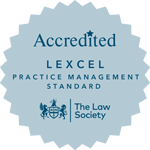One of the questions we are most frequently asked is, ‘Can I sue my surveyor for negligence?’
“I bought my house, moved in, put up the curtains – then I noticed a huge crack in the wall. A friendly builder came round and told me it was subsidence. But nothing was mentioned in the report the surveyor gave me, so can I sue my surveyor for negligence?”
Our specialist professional negligence solicitors, independently ranked among the very best in the UK, are often asked about suing a surveyor. In fact, it is one of the issues that most frequently pops up on our helpline. Here is a short overview of the issues that need to be considered when contemplating a surveyor’s negligence claim.
When a professional negligence lawyer looks at a potential negligence claim against a surveyor the first thing that needs to be established is the type of survey that was carried out. There are three types:
- Valuation;
- Homebuyers report; and
- Structural survey.
A valuation is usually required if you are buying a property with the aid of a mortgage. It is really for the mortgage company’s benefit – to make sure there is sufficient security in your property in case you default and they need to sell the house. It is purely an exercise to assess whether the property is worth the money you are paying, but will not necessarily highlight any structural problems with the property itself.
A Homebuyers Report is the next option and is suitable for properties that are in good condition. The Surveyor will assess the property, identifying any major faults in accessible parts of the building (they won’t pull back the carpets or lift the furniture). They will check for damp, identify any urgent and obvious problems that need attention and usually give you a valuation of the property for mortgage and insurance purposes.
A Full Structural Survey is more expensive than the Homebuyers Report, but goes into much greater detail, reviewing all major and minor structural issues with the property. They still won’t pull back the carpets or lift the furniture unless it is obvious that there is a problem in which case, the report will detail the extent of the problem and give recommendations for future work.
So back to the original question: ‘Can I sue my surveyor? Or more precisely, if I sue my surveyor, am I likely to win?
Negligence claims involving valuation reports are the most difficult professional negligence cases to prove. As long as the valuation is within the correct ‘ballpark’ then the surveyor is probably safe, though we have known of instances where incorrect information has been given that would give rise to legal liability.
In a case of suspected subsidence it is very unlikely that liability would arise on a mortgage valuation alone. There are of course exceptions. The situation might be different for instance if the property you have bought is in a known area of subsidence.
If you had a Full Structural Survey you will be on much firmer ground, even if your property isn’t! In all likelihood, the answer will be “yes”- unless the subsidence occurred after the survey was carried out or was beyond detection. As for the Homebuyers Report, it depends. Was the subsidence obvious and would a reasonably competent surveyor have noticed it?
Whatever type of survey you had, surveyors negligence cases are rarely straightforward. It’s therefore important that you choose a solicitor who is a specialist in the field and experienced in dealing with surveyors professional negligence claims.
If you have been let down by a surveyor and want to know, ‘Can I sue my surveyor for negligence?’ then contact us for a free initial assessment of your case at [email protected]


